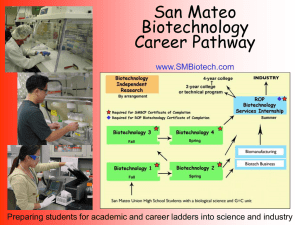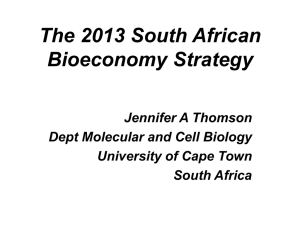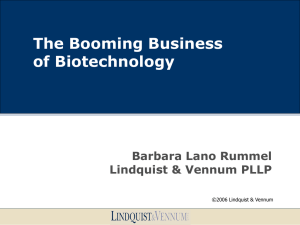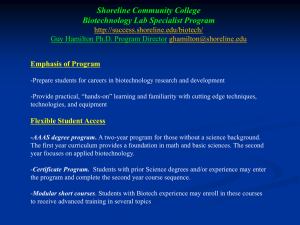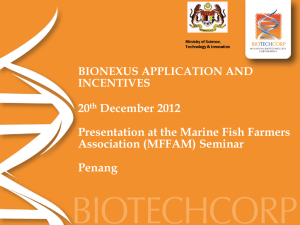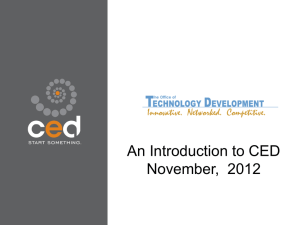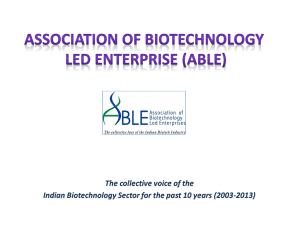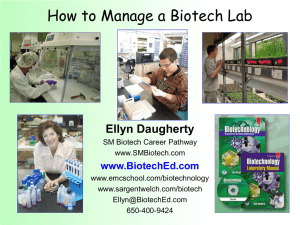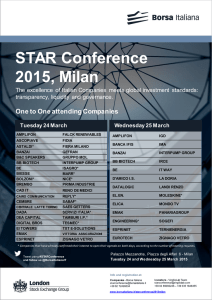Feb2015_BiotechGood4Everybody
advertisement
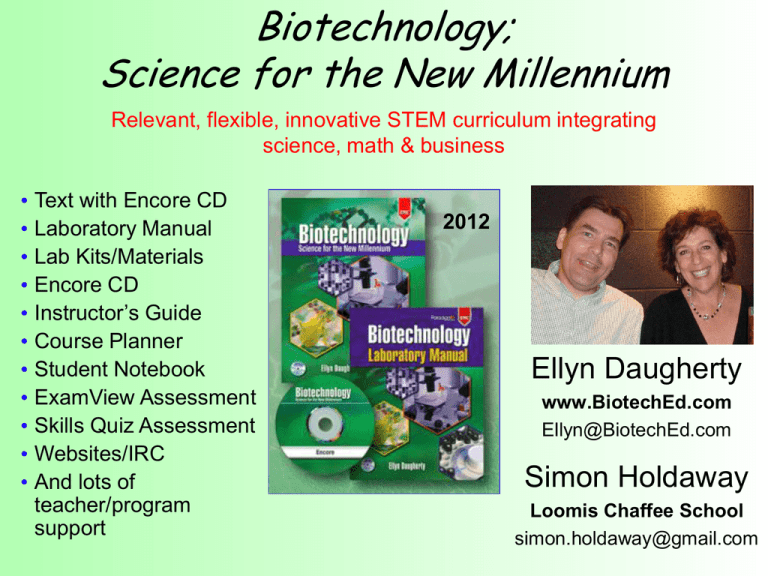
Biotechnology; Science for the New Millennium Relevant, flexible, innovative STEM curriculum integrating science, math & business • • • • • • • • • • • Text with Encore CD Laboratory Manual Lab Kits/Materials Encore CD Instructor’s Guide Course Planner Student Notebook ExamView Assessment Skills Quiz Assessment Websites/IRC And lots of teacher/program support 2012 Ellyn Daugherty www.BiotechEd.com Ellyn@BiotechEd.com Simon Holdaway Loomis Chaffee School simon.holdaway@gmail.com What is Biotechnology? Who uses biotechnology? What products does biotech yield? Biotechnology is the application of biology, chemistry, and engineering research and manufacturing techniques to create products or services to improve the quality of human life. Biotechnology: Science of the Future We are in “The Age of Biotechnology.” Employment of biotech scientists is projected to grow over 11% percent from 2012 to 2022, faster than the average for all occupations (US Dept. of Labor, 2014) Biotechnology is practiced by: Medical Scientists Biological Technicians Medical and Clinical Lab Technologists Biochemists Biophysicists Biomedical Engineers Microbiologists Epidemiologists Research and Development Scientists Process Development Scientists Biomanufacturing Specialists/Operators Bioinformaticians Biotechnology: Science of the Future Biotechnology scientists will be needed for the next 100 years: • The aging baby-boom population and the demand for lifesaving new drugs and procedures to cure and to prevent disease will drive demand for biologists, biochemists, and biophysicists involved in biomedical research. • Greater demand for clean energy will increase the need for biochemists that research and develop alternative energy sources, such as biofuels. • A growing population and rising food prices will fuel the development of genetically engineered crops and livestock that provide greater yields and require fewer resources. • Efforts to discover new and improved ways to clean up and preserve the environment will increase the demand for biotechnologists. • As the amount of biological data continues to grow and computer analytical techniques and software continue to become more sophisticated, the number of dedicated bioinformaticians will continue to grow. Biotech Education Important in the US • The US is the largest market of biotech products and services (medical, agricultural, industrial, environmental, research, defense) and has thousands of biotechnology firms and private industry, academic and government agencies using biotechnology • Between 2001 and 2010, the U.S. bioscience industry grew by 6.4%, adding more than 1.6 million jobs. By comparison, total employment for all private sector industries in the US fell by 2.9 %. • Employment of biochemists and biophysicists (important, well-paying jobs) is projected to grow 19 % from 2012 to 2022. The average annual salary of a biotechnology worker is $81K versus $35K for other professions. • All US metro areas have significant biotech research and manufacturing. Biotech education gives students a variety of academic and career options. What a Biotech Lab Class Looks Like Students: • Doing high level, relevant science • Curious and engaged • Performing high-tech lab work • Processing and sharing data • Practicing critical thinking • Exploring their place in the future Biotech is STEM Key Features of an Excellent Biotechnology Education Program Relevant curriculum supports biotech laboratory process, skill development and workplace awareness • Comprehensive text with concepts and activities that support biotechnology literacy, understanding of scientific processes, bioscience vocabulary development, and biotech workplace awareness • Lab manual that focuses on the development of biotech laboratory skills, lab confidence, self-directedness, and appropriate workplace ethic. • Teacher/Student Encore CD for instruction, reinforcement, and remediation. • Instructor’s Guide, Course Planner, IRC, websites, and teacher workshops with continuing support for both instructors and students. www.emcp.com/biotech www.gbiosciences.com/BTSNM.aspx www.BiotechEd.com Features of the Textbook Chapter Features 1. Biotechnology Career Focus 2. Chapter Learning Objectives 3. Vocabulary/Key Terms 4. Section Review Questions 5. Biotech Online Extension Activities 6. Chapter Summary 7. Lab Skills Summary 8. Thinking Like a Biotechnician Questions 9. Biotech Live Activities/Projects 10.Bioethical Dilemmas Also available as e-Book (1- or 6- year license) Features of the Lab Manual • Lab Chapter Prelude/Introduction • Laboratory Activities – Background, Purpose, Materials List – Procedures (in short easy to follow steps) – Data Analysis/Conclusion – Thinking Like a Biotechnician Questions • Scientific Methodology and critical thinking emphasized Encore CD PACKAGED with TEXT and LAB MANUAL • Lab Tutor - 25 lab skills PPT presentations (narrated) and instructional video clips • Narrated Glossary and Image Bank • Flash Cards and Crossword Puzzles • Quizzes • Link to Internet Resource Center “Julia Child” like lab video clips Features of the Instructor’s Guides Part 1 “Instructor’s Guide” (How to Start a Program) • • • • • Program Overview Starting a Biotechnology Program Authentic Assessment Feedback to the Author Additional Student Resources – Safety – Metrics Review – Excel Data Tables Tutorial – Excel Graphs Tutorial – Writing Conclusions – Internet Tutorial – Glossary of Key Terms Part 2 Course Planner = Lesson Plans (How to Implement a Program) – For the teacher: what to say and how and when to say it (if needed) Student Internet Resource Center • Text Lecture Hall – Learning Outcomes – Chapter Summaries/ Glossaries – Web Links – Biotechnology Acronyms – Successful Web Searching • Student Center – Using the Encore CD – Communicating Online – Course Success – Library • Testing Center – Tips for Taking Tests – Lab Manual Quizzes Instructor Internet Resource Center: • Course Planning Tools – Course Plans (Concepts, Concepts & Lab, Lab) – Lesson Plans (Text) – Lesson Plans (Lab Manual) • Course Presentation Tools – PowerPoint Presentations – Image Bank (illustrations) – Resources (charts/tables) • Course Evaluation Tools – Guidelines for Authentic Assessment – Chapter Exercise Answers – Unit Tests and Answers – ExamView Test Generator Guide Author’s Teacher Support Website www.BiotechEd.com • New Activities • Possible Lab Results/Photos • Helpful Hints • Program Updates • Teacher Training Workshop Dates • Teacher Training PPTS • Link to G-Bio Lab Materials • Internet Resource Center Link • Biotechnology News Link Biotechnology: Science for the New Millennium • The most comprehensive, flexible, relevant curriculum available. > Curriculum maybe used for any length program (semester, year, 2-years or more) > Curriculum may be customized to any student population (medical, environmental, industrial, R&D biotech programs) (processed-based or concept based) • The most support available for any biotechnology curriculum. In addition to training and good curriculum we have: > The IRC and Teacher support website (www.BiotechEd.com) > Teacher workshops and professional development by author/consultant > Excellent customer service and support Ellyn Daugherty Simon Holdaway Colin Heath, G-Biosciences, cheath@gbiosciences.com EMC Customer Service Research and Development Quality Control •Students are Biomanufacturing Biotech is Good for Everybody Business Biotech Biotechnology is an opportunity to teach science in a way that results in science literacy, research skills & career awareness for virtually every student.
